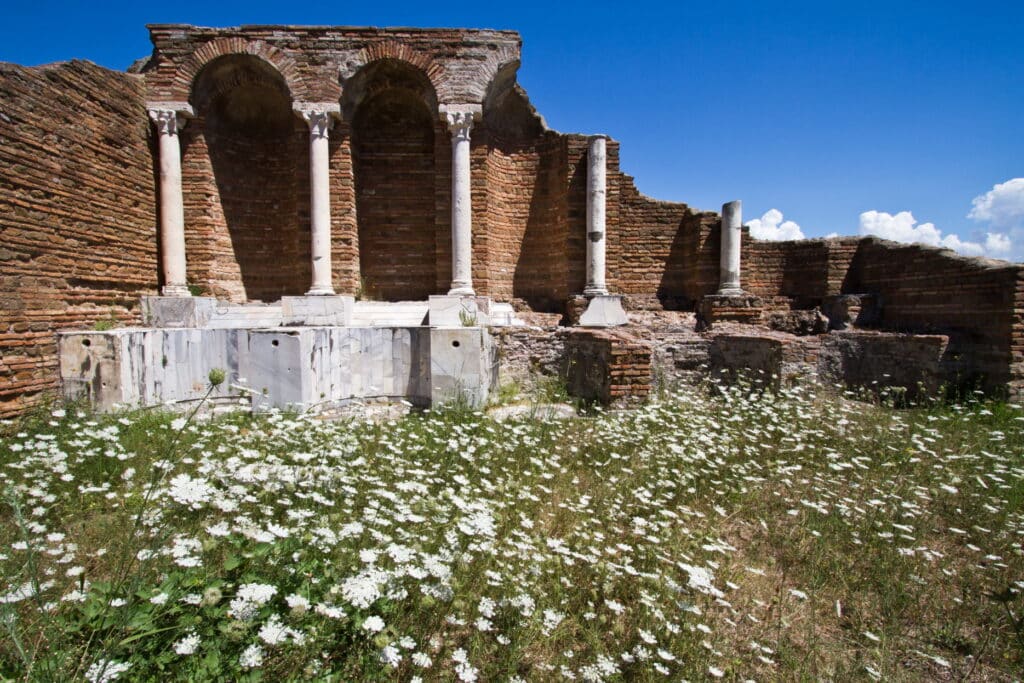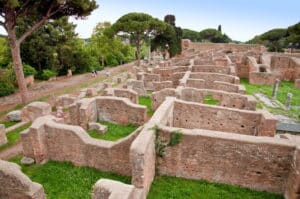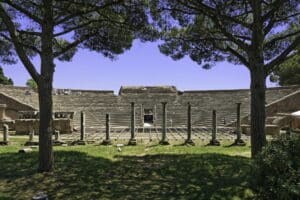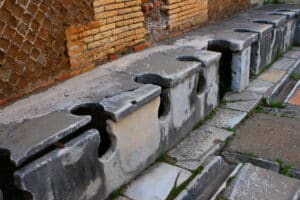
Ostia Antica entrance fee is 18.00€ for 2025. Ostia Antica ticket is valid for 7 days after purchase. You can reach Ostia Antica by trains departing from San Paolo in Rome, or you can choose Ostia Antica tours departing from Rome.
No site in the neighbourhood of Rome gives such a vivid and comprehensive impression of an ancient city as Ostia Antica, the excavated remains of Roman Ostia. According to Roman legend it was here, at the mouth (ostium) of the Tiber, that Aeneas, forefather of the Latins, landed in Italy and King Mdrtius established a settlement in the 7th c. B.C.

Neptune baths ruins at Ostia Antica – Rome – Italy. Photo Credit: Colosseum Rome Tickets – Ostia Antica
Archaeological investigation has shown, however, that it was only about 335 B.C. that a little fishing and trading town grew up here on the banks of the Tiber and on the sea coast. This settlement flourished and developed along with Rome, and under the Empire became one of the busiest and most important Roman commercial and naval ports, with a population of some 10,000: a status which is clearly reflected in the extensive surviving remains.
In later centuries the town fell into oblivion, for a variety of reasons. The importance of Rome as a political and commercial centre showed a steady decline, with the division of the Empire in the reign of Constantine, the fall of the Western Empire in the 5th c. and the troubles of the medieval period; the Tiber deposited increasing quantities of silt around its mouth, so that the sea moved steadily farther away from Ostia; the area was plagued by malaria; and finally the construction of a canal at Fiumicino in 1613 deprived the town of its maritime trade.

Ostia Antica
Excavations carried out since the 1 9th c. have brought to light more than half the town’s area of 66 ha (165 acres), revealing streets and dwelling-houses, theatres and administrative buildings, temples and barracks, shops and workshops, tombs and warehouses, baths and city gates, inns and hostels, sports facilities and port installations, statues and mosaics. The excavations have yielded not merely a series of unrelated remains but the layout of a complete urban organism, with its division into five wards or districts and its rectangular street plan.
It is possible to drive into the excavation site (Scavi) and leave your car in the car park. Alternatively you can start your tour on foot from the main entrance. In the latter event you follow the Via dei Sepolcri (Street of Tombs), pass through the Porta Romana and continue along the Decumanus Maximus (part of the Via Ostiense, the road from Rome) to the theatre, passing on the way the Piazzale della Vittoria (with a statue of Minerva Victoria, the goddess of victory), baths, warehouses (horrea) and dwelling-houses.

Roman latrines, Ostia Antica
Even a brief tour should include at least the following: First, the theatre. Built in the reign of Augustus, altered under Septimius Severus and Caracalla and restored some years ago, it can accommodate an audience of some 2700. Performances are given here during the summer. From the auditorium there is a view of the Piazzale delle Corporazioni behind the theatre, with the offices of 70 business firms and shipping agents, their business and place of origin being indicated by mosaics on the floor. In the centre of the square is the Temple of Ceres. To the right can be seen the Caserma dei Vigili (Watchmen’s Barracks), a palaestra (a sports and athletic ground) and the Baths of Neptune. On the opposite side of the Decumanus Maximus are the Warehouses of Hortensius and beyond these an area which has not yet been excavated.
Beyond the theatre are the handsome House of Apuleius (Casa di Apuleio) and a mithraeum (shrine of Mithras), and on the opposite side of the main street the Collegium Augustale and the House of Fortuna Annonaria, amid a closely packed complex of dwelling-houses. From here continue S to the temple of the Magna Mater (Cybele) and return to the main street, passing on the way the Forum Baths, the Temple of Rome and Augustus and the Casa dei Triclini. In the Forum, adjoining the Temple of Rome and Augustus, is the Basilica, and at the far end of the Forum, dominating the scene, is the Curia.
The tour of the site can be extended to take in the Tempio Rotondo, the Scuola di Traiano, the Piazzale della Bone Dea, the Casa a Giardino (dwelling-houses, gardens and arcades), the Baths of Mithras, temples of the republican period, the House of Amor and Psyche, the Little Market, the Casa dei Dipinti and the Casa di Diana. There is also an interesting museum containing finds from the site.

